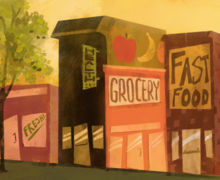London’s best qualities show during response to tragedy
A queue of police force members walked in a line, their black uniforms crisp, heads decked with caps and faces solemn. A swarm of tourists stood in a corner of the street, watching the event unfold in front of them.
Closer to the scene, a sign was wedged somewhat sloppily between the two silver steel handles in the gate of the entrance to Borough Market, one of London’s busiest wholesale food markets. It was closed for the funeral of Keith Palmer.
Police constable Palmer was among the six who lost their lives during the terrorist attack in Westminster on March 22. The Metropolitan police officer was killed by the attacker. He died guarding the Parliament.
London has gone through its fair share of crises, but in times of terror and uncertainty, the city’s most redeeming quality has been its ability to pull itself together and present a united front. It’s remarkable.
The Westminster attack was followed by a swift and efficient response. Things quickly went back to normal and people continued to live their lives. But the people who lost their lives were certainly not forgotten. Londoners paid tribute by creating shrines at Westminster, adding fresh flowers and supportive messages to the area every day.
The people of the city showed their strength and solidarity on social media, circulating images of Big Ben and other London icons, expressing their love for the city and their thoughts for the families of victims. London bounced back from a horrific event with great resonance, while paying their respects to those who lost their lives.
London showed a similar response on July 7, 2005, when a series of suicide bomb attacks planned by Islamist extremists occurred on the Underground public transportation system. The attack killed 52 people and injured hundreds.
Besides serving as a wake-up call for security and members of the city in general, the months after the 2005 attack saw massive changes in city bollard structures, security service reforms, digital data gathering, communicating in the Underground and much more.
At the same time, just a few hours after the bomb explosions, websites had already gone up celebrating the war on terrorism and inviting Londoners to share their defiance of terrorism. A vigil was held, sponsored by the Stop the War Coalition and the Muslim Association of Britain. After this, the English continued living, and a lot was changed about the way the city handles attacks of terrorism.
London’s ability to bounce back from attacks and threats is one of the ways it is such a powerful city. Although the country as a whole has been at severe threat of terrorism for a long time, the people do not live in fear of terror. In fact, they are determined to not be afraid, and not let attacks stop them from living their lives to the fullest.
Although London is one of the most multicultural places in the world, made up of thousands of ethnic communities and people from different backgrounds, crises bring the people of the city together, uniting them in the face of vulnerability and danger.
It would be an impossible task to create a society where danger is nothing but a figment of the imagination, where fear doesn’t exist. However, Londoners, despite their plethora of differences, will find common ground in the face of an attack. In the end, the love Londoners have for their city overpowers their individual differences, allowing them to continue living in a city determined to never let terror break its spirit.
Saniya More is a sophomore international relations and broadcast and digital journalism dual major. Her column appears weekly in Pulp. She can be reached at ssmore@syr.edu.
Published on April 10, 2017 at 9:30 pm





